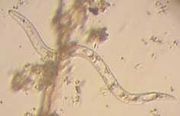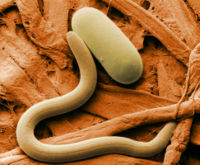Nematode
2008/9 Schools Wikipedia Selection. Related subjects: Organisms
| Nematodes | ||||
|---|---|---|---|---|
 |
||||
| Scientific classification | ||||
|
||||
| Classes | ||||
|
Adenophorea |
The nematodes or roundworms ( Phylum Nematoda from Greek νῆμα (nema): "thread" + -ώδη -ode "like") are one of the most common phyla of animals, with over 80,000 different described species (of which over 15,000 are parasitic). They are ubiquitous in freshwater, marine, and terrestrial environments, where they often outnumber other animals in both individual and species counts, and are found in locations as diverse as Antarctica and oceanic trenches. Further, there are a great many parasitic forms, including pathogens in most plants, animals, and also in humans.
The nematodes were originally named nematoidea by Rudolphi (1808). They were renamed nematodes by Burmeister 1837 (as a family; Leuckart 1848 and von Siebold 1848 both promoted them to the rank of order), then nematoda ( Diesing 1861), though Nathan Cobb (1919) argued that they should be called nemata or nemates (and in English 'nemas' rather than 'nematodes'). After some confusion which saw the nematodes placed (often together with the horsehair worms, nematomorpha) as a class or order in various groups such as Aschelminthes, Lankester (1877) definitively promoted them to the level of phylum.
Morphology
Roundworms are unsegmented, bilaterally symmetric and triploblastic protostomes with a complete digestive system. Roundworms have no circulatory or respiratory systems so they use diffusion to breathe. Although they lack a circulatory system, nutrients are transported throughout the body via fluid in the pseudocoelom. They are thin and are round in cross section. Nematodes are one of the simplest animal groups to have a complete digestive system, with a separate orifice for food intake and waste excretion, a pattern followed by all subsequent, more complex animals. The body cavity is a pseudocoelom (persistent blastula), which lacks the muscles of coelomate animals that protects the body from drying out, from digestive juices, or from other harsh environments. Although this cuticle allows movement and shape changes via a hydrostatic skeletal system, it is very inelastic so does not allow the volume of the worm to increase. Therefore, as the worm grows, it has to molt and form new cuticles. The cuticles don't allow volume to increase so as to keep hydrostatic pressure inside the organism very high. For this reason, the roundworms do not possess circular muscles (just longitudinal ones) as they're not required. This hydrostatic pressure is the reason the roundworms are round.
Nematodes have a simple nervous system, with a main ventral nerve cord and a smaller dorsal nerve cord. Sensory structures at the anterior end are called amphids, while sensory structures at the posterior end are called phasmids.
Most free-living nematodes are microscopic, though a few parasitic forms can grow to over a meter in length (typically as parasites of very large animals such as whales). There are no circular muscles, so the body can only undulate from side to side. Contact with solid objects is necessary for locomotion; its thrashing motions vary from mostly to completely ineffective at swimming.
Nematodes generally eat bacteria, fungi and protozoans, although some are filter feeders. Excretion is through a separate excretory pore. Nematodes also contract bacterial infections within excretion pores.
Reproduction
Reproduction is usually sexual. Males are usually smaller than females (often much smaller) and often have a characteristically bent tail for holding the female for copulation. During copulation, one or more chitinized spicules move out of the cloaca and are inserted into genital pore of the female. Amoeboid sperm crawl along the spicule into the female worm. Nematode sperm is thought to be the only eukaryotic cell without the globular protein G-actin.
Eggs may be embryonated or unembryonated when passed by the female, meaning that their fertilized eggs may not yet be developed. In free-living roundworms, the eggs hatch into larva, which eventually grow into adults; in parasitic roundworms, the life cycle is often much more complicated.
Some nematodes, specifically Heterorhabditis spp., undergo a process called endotokia matricida; intrauterine birth causing maternal death. The hermaphroditic nematode keeps its self-fertilized eggs inside its uterus until they hatch. The juvenile nematodes will then ingest the parent nematode. This process is significantly promoted in environments with a low or reducing food supply.
Free-living species
In free-living species, development usually consists of four molts of the cuticle during growth. Different species feed on materials as varied as algae, fungi, small animals, fecal matter, dead organisms and living tissues. Free-living marine nematodes are important and abundant members of the meiobenthos. They play an important role in the decomposition process, aid in recycling of nutrients in marine environments and are sensitive to changes in the environment caused by pollution. One roundworm of note is Caenorhabditis elegans, which lives in the soil and has found much use as a model organism. C. elegans has had its entire genome sequenced, as well as the developmental fate of every cell determined, and every neuron mapped.
Some nematodes can undergo cryptobiosis.
Abundance
The nematode species are very difficult to distinguish. Of the pseudocoelomates, the nematodes are the most common. Nematodes have successfully adapted to nearly every niche from marine to fresh water, from the polar regions to the tropics, as well as the highest to the lowest of elevations. They represent, for example, 90% of all life on the seafloor of the Earth. Though 20,000 species have been classified it is estimated that this number might be upwards of 500,000 if all were known.. In certain fertile areas the topsoil is estimated to contain in the billions of nematodes per acre. In the 1914 edition of the Yearbook of the United States Department of Agriculture N.A.Cobb wrote on the abundance of nematodes:
| “ | If all the matter in the universe except the nematodes were swept away, our world would still be dimly recognizable, and if, as disembodied spirits, we could then investigate it, we should find its mountains, hills, vales, rivers, lakes and oceans represented by a thin film of nematodes. The location of towns would be decipherable, since for every massing of human beings there would be a corresponding massing of certain nematodes. Trees would still stand in ghostly rows representing our streets and highways. The location of the various plants and animals would still be decipherable, and, had we sufficient knowledge, in many cases even their species could be determined by an examination of their erstwhile nematode parasites. | ” |
|
— N.A.Cobb
|
Parasitic species
Nematodes commonly parasitic on humans include whipworms, hookworms, pinworms, ascarids, and filarids. The species Trichinella spiralis, commonly known as the trichina worm, occurs in rats, pigs, and humans, and is responsible for the disease trichinosis. Baylisascaris usually infests wild animals but can be deadly to humans as well. Haemonchus contortus is one of the most abundant infectious agents in sheep around the world, causing great economic damage to sheep farms. In contrast, entomopathogenic nematodes parasitize insects and are considered by humans to be beneficial.
One form of nematode is entirely dependent upon the wasps which are the sole source of fig fertilization. They prey upon the wasps, riding them from the ripe fig of the wasp's birth to the fig flower of its death, where they kill the wasp, and their offspring await the birth of the next generation of wasps as the fig ripens.
Plant parasitic nematodes include several groups causing severe crop losses. The most common genera are: Aphelenchoides ( foliar nematodes), Meloidogyne (root-knot nematodes), Heterodera, Globodera (cyst nematodes) such as the potato cyst nematode, Nacobbus, Pratylenchus (lesion nematodes), Ditylenchus, Xiphinema, Longidorus, Trichodorus. Several phytoparasitic nematode species cause histological damages to roots, including the formation of visible galls (Meloidogyne) which are useful characters for their diagnostic in the field. Some nematode species transmit plant viruses through their feeding activity on roots. One of them is Xiphinema index, vector of GFLV (Grapevine Fanleaf Virus), an important disease of grapes.
Other nematodes attack bark and forest trees. The most important representative of this group is Bursaphelenchus xylophilus, the pine wood nematode, present in Asia and America and recently discovered in Europe.
The largest nematode ever recorded, Placentonema gigantissima, was discovered parasitizing the placenta of a sperm whale, measuring 8.5 m in length with a diameter of 0.3 mm, and containing 32 ovaries.
Other large nematodes include: Dioctophyma renale, the giant kidney worm, a parasite most commonly found in mink but also in dogs and humans, that can reach up to 103 cm in length.
Nematodes in Agriculture
Depending on the species, a nematode may be beneficial or detrimental to plant health.
From an agricultural perspective, there are two categories of nematode: predatory ones, which will kill garden pests like cutworms, and pest nematodes, like the root-knot nematode, which attack plants.
Predatory nematodes can be bred by soaking a specific recipe of leaves and other detritus in water, in a dark, cool place, and can even be purchased as an organic form of pest control.
Rotations of plants with nematode resistant species or varieties is one means of managing parasitic nematode infestations.
Phylogeny
Morphological characters and molecular phylogenies place the Nematoda as sister taxon to the parasitic Nematomorpha (together Nematoida). The Nematodes belong to the Cyclioneuralia, a clade that consists out of Nematoida, Pripulida, Loricifera and Kinorhyncha. The cloesest relatives of these animals are the arthropods (insects, crustaceans, myriapods and chelicerates). All these molting animals form a clade called Ecdysozoa (Aguinaldo et al 1998; Dunn et al 2008).
That the roundworms have a large number of peculiar apomorphies and in many cases a parasitic lifestyle confounds analyses; the DNA sequence data hitherto analyzed is equivocal on ecdysozoan monophyly. Genetic analyses of roundworms suggest that - as is also indicated by their unique morphological features - the group has been under intense selective pressure during its early radiation, resulting apparently in accelerated rates of both morphological and molecular evolution.
Robustness
- Hundreds of nematode worms (C. elegans), featured in a research project on mission STS-107, survived the Space Shuttle Columbia Disaster.
